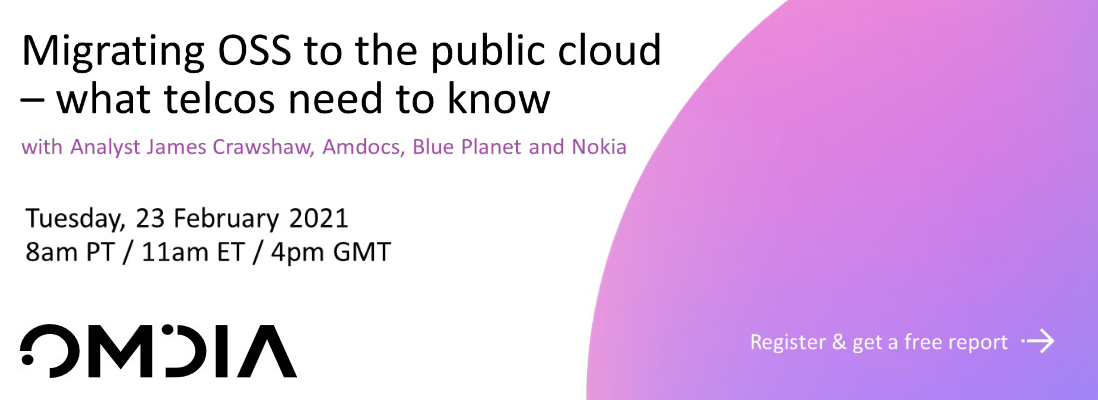Blue Planet powers your cloud-first strategy
Communications Service Providers (CSPs) have a long history with cloud computing, both as providers and consumers. Whether hosting applications, delivering managed services, or running virtualized network functions (VNFs), CSPs have used cloud technology to increase efficiency and generate revenue. In fact, many forward-looking CSPs have adopted a ‘cloud-first’ strategy and are now looking to migrate their service design, fulfillment, and assurance applications to the public cloud, and to form closer partnerships with cloud providers in anticipation of mainstream 5G and edge cloud deployments.
James Crawshaw, a principal analyst at Omdia, covered these developments in a recent report titled Public Cloud for OSS (subscription required). In the report, James cites that many CSPs have successfully migrated mobile core software, as well as a variety of Business Support Systems (BSS), to the public cloud, and he expects that Operational Support Systems (OSS) will soon follow.
The Omdia report cautions that simply moving legacy OSS apps to the cloud isn’t likely to make business sense, and that CSPs will need to invest in re-platforming or re-factoring effort to add value to the migration. Alternatively, CSPs could replace their legacy OSS with modern OSS applications that can easily be hosted in the cloud; better yet, they could simply consume cloud-native OSS applications hosted in the public cloud, using a Software-as-a-Service (SaaS) model.
"The logical next step beyond migrating OSS to the public cloud is for operators to consume it on a SaaS basis."- James Crawshaw, principal analyst, Omdia
Cloud native software is based on loosely coupled, microservice-specific software containers that communicate using APIs to build applications. This approach overcomes the inflexibility of tightly integrated legacy applications, making cloud-native software easier to enhance, maintain, and scale. Simply put, applications must have a cloud-native software architecture in order to fully realize the advantages that the cloud offers.
Our Blue Planet Intelligent Automation software, which is built on a container-based microservices architecture, is cloud-native by design. Among many other benefits, this means that all Blue Planet products and solutions can be deployed on-prem or in cloud environments -- without restriction, and with the exact same features. In fact, we have worked closely with Amazon Web Services (AWS), the world’s most comprehensive and broadly adopted cloud platform, to make Blue Planet available as a SaaS offer.
Pablo Sandoval, Senior Segment Lead, Networking, at AWS provided some additional insight on the effort:
“We provide AWS Partners like Blue Planet with the business and technical resources they need to succeed on AWS, whether they are modernizing existing applications or building new products. Their cloud-native architecture enabled a very straight-forward implementation, and we are very pleased to see Blue Planet become an innovative vendor in the OSS space and offer their entire portfolio as-a-service on AWS.”- Pablo Sandoval, Senior Segment Lead, Networking, at Amazon Web Services (AWS)
Importantly, many innovative CSPs are already profiting from our cloud-native flexibility. For example, BT Global Services - a division of BT Group that provides security, cloud and networking services to multinational companies worldwide - uses Blue Planet software in their private cloud to provide their customers with fast and reliable access to cloud-based collaboration tools and sophisticated digital applications. By deploying Blue Planet in their cloud, BT Global Services can offer self-service options to customers around the world while concurrently maximizing their network resource utilization and ensuring that their strict security and availability criteria are consistently maintained.
At the same time – and quite a bit closer to home for me – Southern Cross Cable Network is consuming Blue Planet in a SaaS model, in support of their innovative Gigaflex elastic bandwidth-on-demand services. Southern Cross is a leading Australasian supplier of international capacity to Carriers and ISPs in Australia and New Zealand, and their Gigaflex service provides up to 100Gbps of on-demand or scheduled trans-Pacific bandwidth. Utilizing Blue Planet as a SaaS lets Southern Cross avoid upfront server and license CAPEX and maintain business agility. Another important business benefit: Blue Planet manages the software lifecycle, freeing up Southern Cross technicians for other more important tasks.
I spoke with Craige Sloots, Director of Marketing and Sales at Southern Cross, about the markets they serve and how Blue Planet and SaaS helps them achieve their goals. Craige said “Customer connectivity and bandwidth needs come in all shapes and sizes; and are often unpredictable. We succeed by giving our customers the ability to easily and rapidly meet their unique business needs, whether it’s a one-time event, a transient occurrence or an ongoing activity.”
“Blue Planet automates service activation across our high capacity, redundant and diverse fibre-optic submarine cable network, which provides dedicated connectivity between Australia, New Zealand, Fiji, Hawaii and the US West Coast.”- Craige Sloots, Director of Marketing and Sales, Southern Cross Cable Network
You can learn more about Blue Planet’s SaaS offers by joining the Migrating OSS to the Public Cloud webinar - hosted by Omdia - on February 23rd. You can also contact us anytime to schedule a detailed discussion and demonstration focused on how Blue Planet Intelligent Automation can transform your IT and operations environments and power your journey to the Adaptive Network. I look forward hearing from you.


